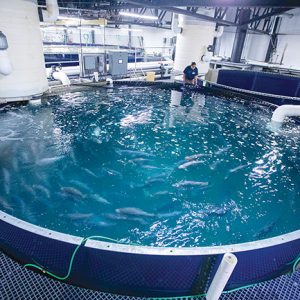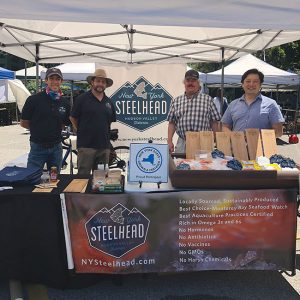
Trout farmer rethinks sales channels
November 11, 2020
By
Liza Mayer
Reluctance to embrace e-commerce was no match to the will to survive
 Hudson Valley Fisheries’ grilling product was featured in The Oprah Magazine
Hudson Valley Fisheries’ grilling product was featured in The Oprah Magazine As the impact of the COVID-19 pandemic rippled through the foodservice industry, John Ng decided to sell his steelhead trout online, but not without initial hesitation.
“I approached e-commerce with a lot of trepidation,” admits Ng, CEO of Hudson Valley Fisheries, a land-based steelhead farm in upstate New York. “We were all concerned because I think people are much more sensitive to the freshness of their seafood than that of the other proteins.”
But he knew there’s a major crisis and expediency was essential. Restaurants account for 40 percent of the farm’s business.
“With the pandemic, our restaurant customers went away for awhile and some of them, unfortunately, did not come back. We really had to pivot our sales channel to keep our production flowing,” he says.
By April, after several trials of shipping fresh steelhead from the farm to various local destinations, the e-commerce site went online. It was an imperfect start; for one thing, shipping rates were considerable. But as sales rose – and they did fairly quickly – the company was able to negotiate “a solid rate” with shipper UPS.
“Our social media strategy of engaging our clients has grown not only the number of our followers but also our online sales. I believe there’s a direct correlation between the two,” says Ng. Before long, a steelhead meal kit from the farm’s online store would also grace The Oprah Magazine as a featured product.
The e-commerce idea germinated before the pandemic and now, looking back, Ng says his hesitation to commit to it at that time is a life lesson. “We would have been able to soften the blow a bit more. Sometimes you just need to take the leap. That was a big lesson,” he said.
Farmers markets in and around Manhattan now also help bring in sales. Together with e-commerce, farmers markets now account for 15 percent of the company’s revenue.
“Last year we did a farmers market in upstate New York. I wasn’t expecting it as a sales channel; it was more of a marketing outreach to educate consumers and chefs about what sustainable seafood looks like and introduce ourselves to the community,” says Ng.
But the pandemic changed that. People were cooking at home a lot more and they are shopping in farmers markets looking for fresh products.
“Local people at our farmers markets are telling me they are much happier and prefer buying directly from the source, buying directly from the farmer instead of a middle man or even from a retailer because having fewer hands on the product is a safer bet – and it is,” says Ng.
Four times a week, Hudson Valley Fisheries is now in farmers markets, including the more popular Union Square location. “A lot of chefs go there. The first day I was there they (old timers) saw the slowest Friday they’ve seen in years. But for us, what we saw was better sales than the other farmers markets we’ve attended. That engaged us to expand.”
New York City extended outdoor dining at restaurants up to the winter. Whether or not this would be enough to save some of Ng’s restaurant clients, only time will tell.
“No one could have foreseen the impact of COVID. It highlighted how dependent we were on the restaurant industry. Our strength was how we came through it by building up our e-commerce and farmers market presence.”
“Overall, our company is so much stronger today than it was in February and March. While we were forced into this situation, we grew stronger. At the end of the day it was a benefit to us that we’ve gone through it,” he says.
“We grew at a time when the world stopped,” he added. “We increased our capabilities, our product offerings, we hired a few more processing staff and a driver. Hats off to the entire team and company for making that happen.”
Advertisement
- Atlantic Sapphire milepost: first harvest hits retail
- Building a ‘new’ industry, one module at a time








